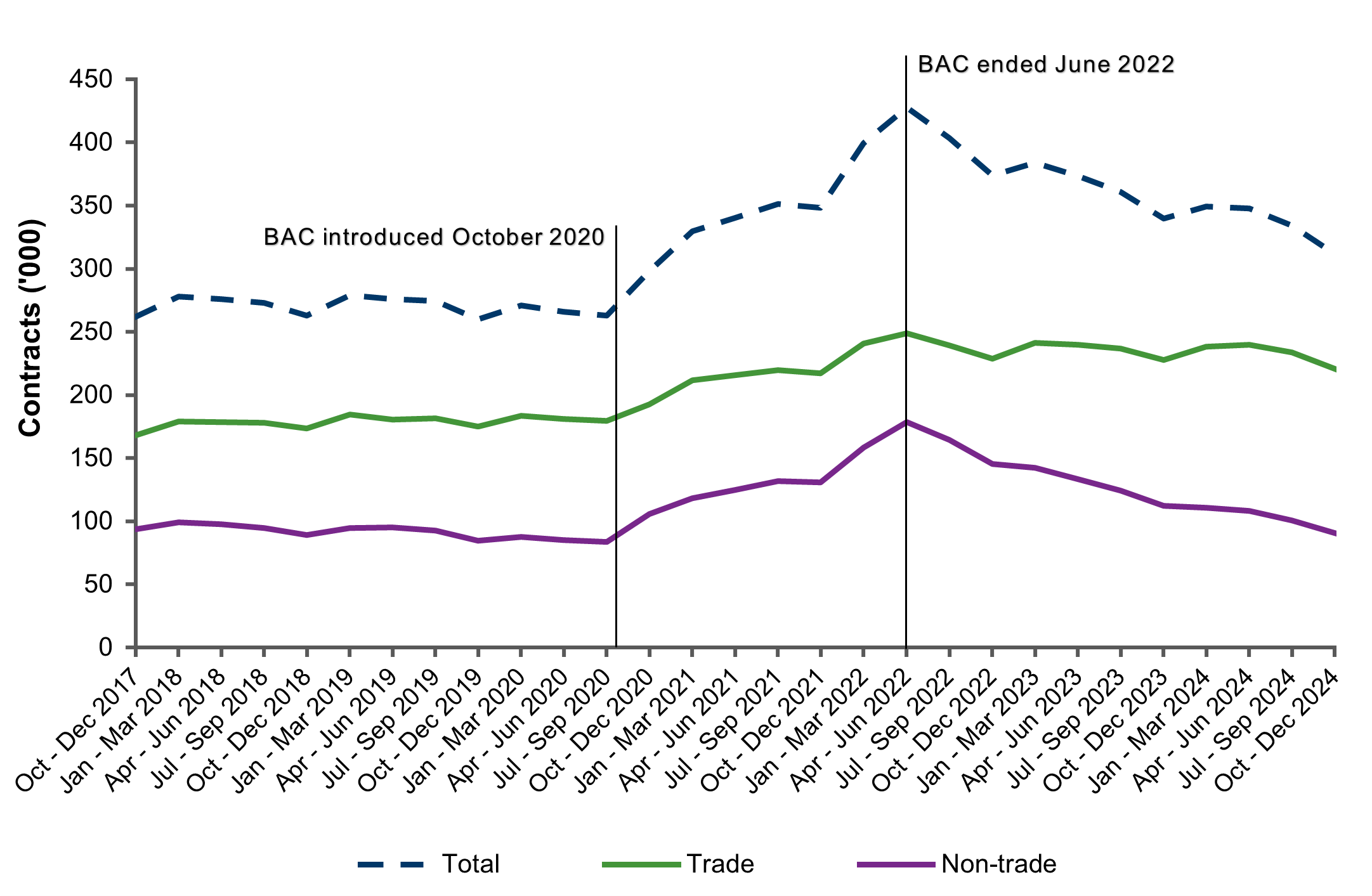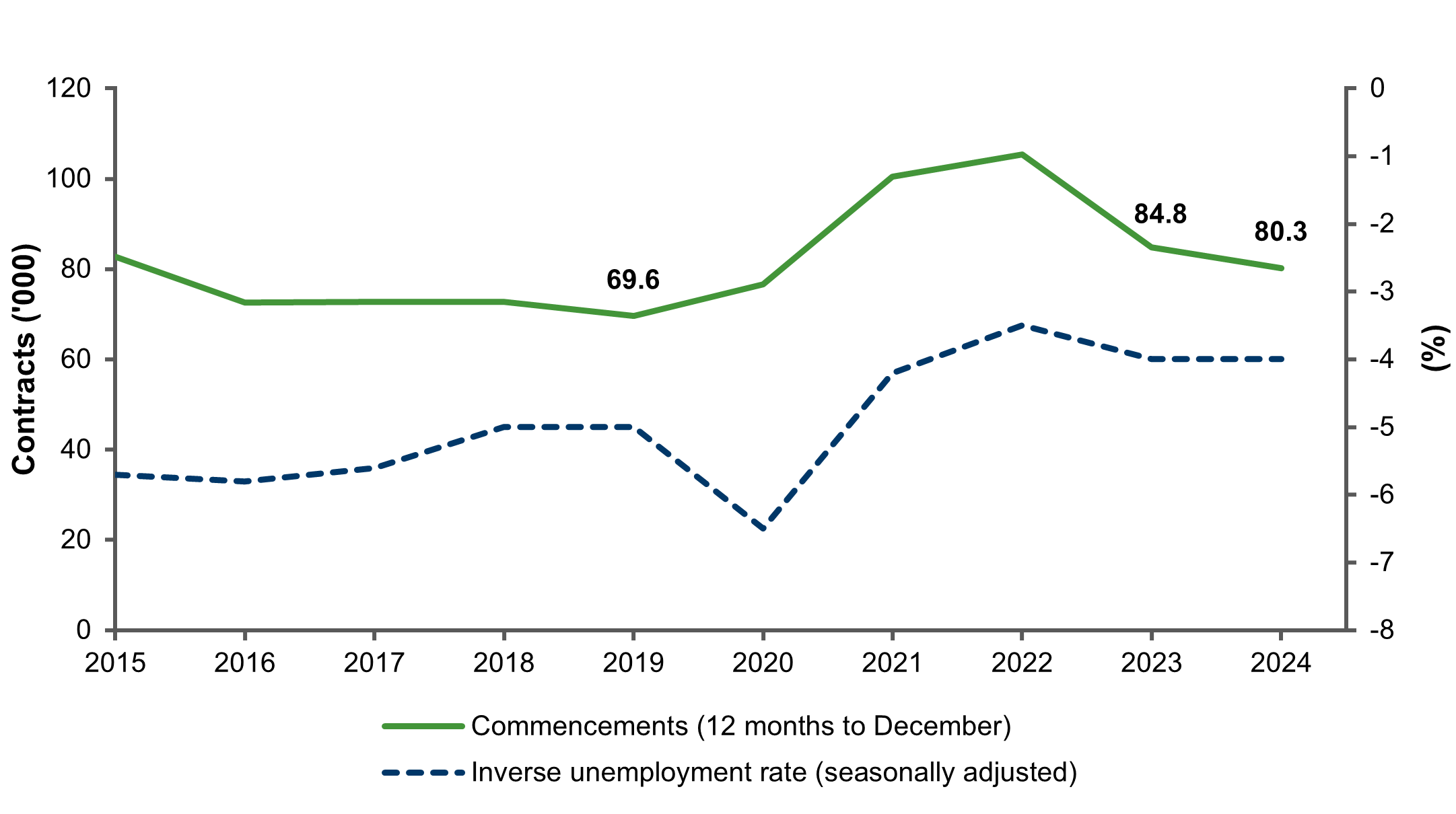New data released today by the National Centre for Vocational Education Research (NCVER) show that the number of apprentices and trainees in training fell by the end of December 2024. This fall was driven in part by a reduction in commencements and an increase in trade completions.
Apprentices in-training down, but higher than pre-pandemic levels
The Apprentices and Trainees 2024: December quarter report shows that the number of apprentices in training declined across both trade and non-trade occupations. Trade numbers decreased by 2.9% compared with December 2023, while non-trade numbers fell more significantly by 19.1%. Despite these falls, both trade and non-trade numbers remain above pre-pandemic levels recorded at the end of December 2019.
Figure 1: Apprentice and trainee contracts in-training as at 31 December by trade status, 2017-24 (‘000)

Trade apprenticeship commencements fall despite strong labour demand
Trade apprenticeship commencements declined by 5.4% in the year to December 2024, despite continued employment growth and strong demand for technicians and trades workers.
The largest declines were among Construction Trade Workers, down 2,805 or 11.9%, and Automotive and Engineering Trades Workers, down 1,345 or 5.8%. Within the construction sector, notable falls were recorded for Carpenters and Joiners, down 1,480 (13.1%), and Plumbers, down 750 (9.2%).
NCVER Managing Director John King said, ‘Employment growth and persistent skills shortages in the trades are not yet translating into higher apprenticeship commencements.
‘People may be declining or deferring formal training in some trades and entering the workforce directly.
‘We may also be seeing the ongoing impact of cost-of-living pressures on both businesses and individuals, making it harder to attract and retain apprentices,’ said Mr King.
Trade apprenticeship commencements have historically tracked closely with the unemployment rate, illustrating their general responsiveness to the broader business cycle.
Figure 2: Trade contract commencements and inverse unemployment rate, December 2015-24

Non-trade commencements down sharply following end of major incentives
In contrast, non-trade apprenticeship commencements fell sharply, declining by 13.9% over the same period. This reflects the training’s higher sensitivity to government policy changes, including the conclusion of the Boosting Apprenticeship Commencements (BAC) scheme.
The largest fall in commencements was among Community and Personal Service Workers, which declined by 5,650 or 15.8%. However, not all non-trade occupations declined. Commencements in Aged and Disabled Care rose by 1,060 (40.7%) in 2024 when compared with the previous year.
Trade completions increase, boosting skilled workforce
While commencements declined, completions in trade occupations had a noticeable increase. In the December quarter 2024, trade completions increased by 1,220 or 8.4% compared with the same quarter in 2023.
The strongest growth in completions occurred in occupations in shortage. Completions among Construction Trade Workers rose by 875 (23.9%) to 4,540, while Electrotechnology and Telecommunications Trades Workers increased by 710 (24.2%) to 3,655. Together, these two groups accounted for more than half of all trade completions in the quarter.
In contrast, non-trade completions declined overall by 1,950 or 12.3%. However, there were positive signs in sectors facing workforce shortages. Child Carers, for example, saw completions rise by 990 (61.2%), reaching 2,605 for the quarter.
Background
Apprentices and trainees 2024: December quarter provides a national picture of apprenticeship and traineeship activity, including both quarterly and annual figures that can be broken down by state and territory.
In-training refers to apprenticeship and traineeship contracts that are still active, meaning they have not been completed, cancelled, withdrawn, or expired without meeting all prescribed program requirements.
Information on issues affecting the Australian labour market is outlined in Jobs and Skills Australia’s Labour Market Update – December 2024.
Download the report: Apprentices and trainees 2024: December quarter
Enquiries: Chantal Deutrom P: +61 8 8230 8418 E: chantaldeutrom@ncver.edu.au
About NCVER: we are the main provider of research, statistics and data on Australia’s VET sector. Our services help promote better understanding of VET and assist policy makers, practitioners, industry, training providers, and students to make informed decisions.
This work has been produced by NCVER on behalf of the Australian Government and state and territory governments, with funding provided through the Australian Government Department of Employment and Workplace Relations.